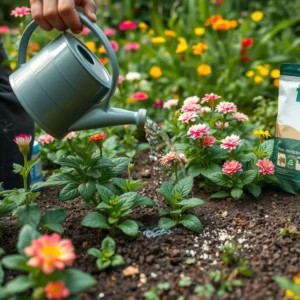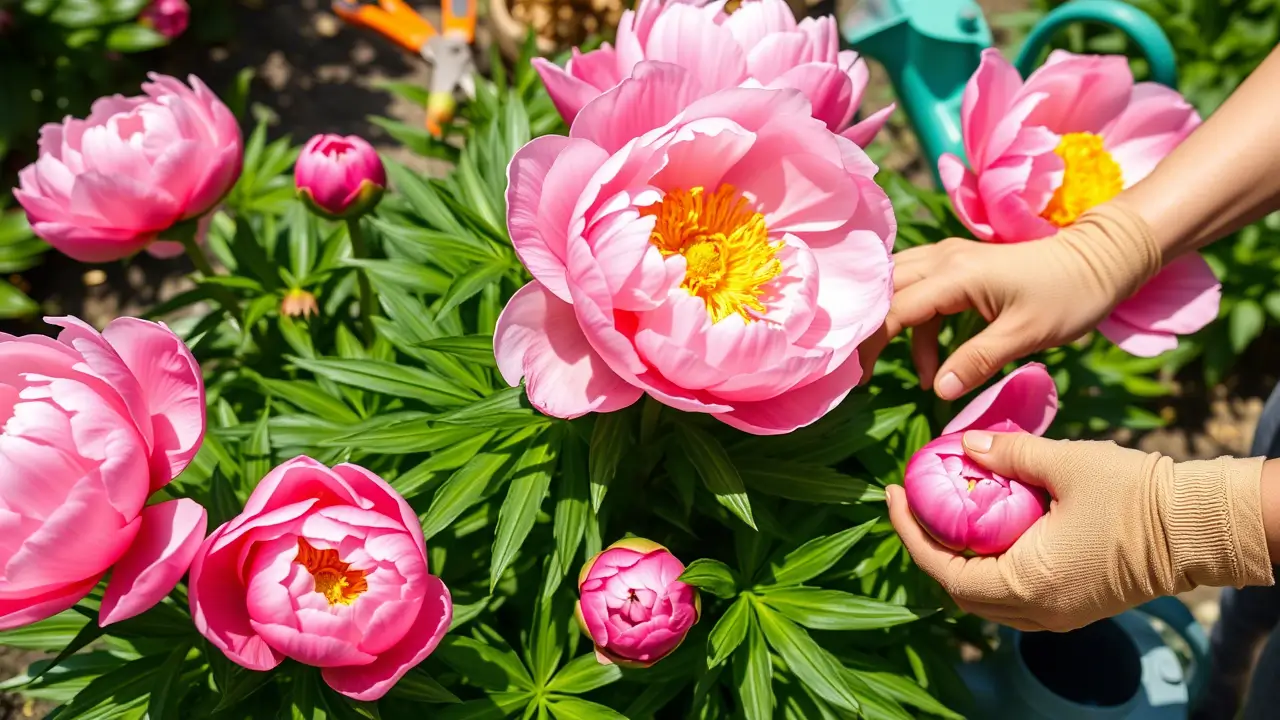Introduction
Few flowers capture the imagination quite like peonies. With their lush, billowing blooms and intoxicating fragrance, these perennial favorites have been cherished by gardeners for centuries. Whether you’re drawn to the classic bowl-shaped blooms of herbaceous peonies or the woody elegance of tree peonies, growing these stunning flowers can be incredibly rewarding.
However, many gardeners find themselves challenged when it comes to peony plant care, especially when dealing with specific regional climate conditions. The good news? With the right knowledge and techniques, you can successfully grow magnificent peonies in almost any garden.
This comprehensive guide will walk you through everything you need to know about how to grow peonies that will be the envy of your neighborhood. From selecting the perfect varieties to ensuring spectacular blooms year after year, we’ve got you covered.

1. Choosing the Right Peony Varieties for Your Region
The key to successful peony growth begins with selecting varieties well-suited to your specific climate. Peonies generally require a period of winter chill (approximately 400+ hours below 40°F) to bloom properly, but some varieties are more adaptable than others.
Climate Considerations
- Cold Hardiness: Most peonies thrive in USDA zones 3-8
- Heat Tolerance: Consider early-blooming varieties if you live in warmer regions
- Humidity: In high-humidity areas, choose varieties resistant to botrytis blight
Recommended Peony Varieties by Region
| Region | Recommended Varieties | Special Features |
|---|---|---|
| Cold Climates (Zones 3-4) | ‘Sarah Bernhardt’, ‘Felix Crousse’, ‘Karl Rosenfield’ | Extremely winter hardy, reliable bloomers |
| Moderate Climates (Zones 5-7) | ‘Coral Charm’, ‘Bowl of Beauty’, ‘Festiva Maxima’ | Versatile performers with spectacular blooms |
| Warmer Climates (Zone 8) | ‘Prairie Charm’, ‘Early Scout’, Itoh hybrids | Earlier blooming, more heat tolerant |
The Itoh peonies (intersectional hybrids) deserve special mention as they combine the best qualities of herbaceous and tree peonies. Varieties like ‘Bartzella’ and ‘Cora Louise’ offer outstanding heat tolerance while producing abundant blooms.
Many quality nurseries specialize in peonies suitable for various regions. Check local garden centers or trusted online retailers like Peony’s Envy, Adelman Peony Gardens, or Hollingsworth Peonies for healthy, region-appropriate plants.
2. Preparing the Soil for Success
Peonies are long-lived plants that can thrive for decades, making proper soil preparation crucial for long-term success.
Understanding Your Soil
Before planting peonies, assess your soil type:
- Clay Soil: Tends to retain too much moisture, potentially causing root rot
- Sandy Soil: Drains quickly but may not retain enough nutrients
- Loamy Soil: The ideal soil type for peonies, with good drainage and nutrient retention
Step-by-Step Soil Amendment
- Test your soil pH: Peonies prefer slightly acidic to neutral soil (pH 6.5-7.0)
- Improve drainage: Add coarse sand or fine gravel if your soil is heavy clay
- Add organic matter: Work in 2-3 inches of compost or well-rotted manure
- Incorporate bone meal: Add 1 cup per planting hole to encourage root development
- Avoid excessive nitrogen: Too much can lead to lush foliage but fewer flowers
For regions with naturally acidic soil, adding garden lime can help raise the pH to peony-friendly levels. In areas with alkaline soil, incorporating peat moss or pine needles can gently lower the pH.
Pro Tip: Prepare your peony planting site about 2-4 weeks before actually planting to allow amendments to integrate with the native soil.
3. Planting Your Peonies
Proper planting technique is perhaps the most critical factor in successful peony growth and flowering.
Timing is Everything
- Fall Planting (Recommended): Plant 4-6 weeks before the ground freezes for best results
- Spring Planting: Possible but may delay blooming by a year
- Avoid Summer Planting: Stress from heat makes establishment difficult
Planting Depth: The Golden Rule of Peony Care
The number one mistake gardeners make is planting peonies too deeply. Follow these guidelines:
- Herbaceous Peonies: Plant with the “eyes” (pink/red buds) no more than 1-2 inches below soil level
- Tree Peonies: Plant with the graft union 4-6 inches below soil level
- Itoh Peonies: Plant with the eyes 1-2 inches below soil level
Step-by-Step Planting Instructions
- Dig a hole 12-18 inches wide and 12-18 inches deep
- Create a small mound in the center of the hole
- Position the peony root on the mound with eyes facing upward
- Backfill with amended soil, gently firming as you go
- Water thoroughly after planting
- Add 2-3 inches of mulch around (but not on top of) the plant
Common Mistake: Planting too deeply is the primary reason peonies fail to bloom. When in doubt, plant more shallowly than you think necessary.
4. Watering and Fertilizing
Proper watering and fertilization schedules ensure healthy growth and abundant flowering.
Watering Guidelines
- Newly Planted: Keep soil consistently moist (not wet) for the first month
- Established Plants: 1 inch of water per week during growing season
- Drought Periods: Increase watering to prevent stress
- Fall Watering: Reduce watering after first frost

In regions with high summer rainfall, ensure good drainage to prevent root rot. In drier climates, consider using soaker hoses to deliver water directly to the root zone without wetting foliage.
Fertilizing Schedule
- Early Spring: Apply a balanced, low-nitrogen fertilizer (5-10-10) as new growth emerges
- After Flowering: Light application of compost or well-rotted manure
- Late Summer: Avoid fertilizing after August to allow plants to prepare for dormancy
For especially healthy plants, incorporate a slow-release organic fertilizer specifically formulated for flowering perennials.
5. Pruning and Deadheading
Proper pruning practices encourage healthy growth and disease prevention.
Deadheading Spent Blooms
- Cut spent flowers back to a strong leaf node
- Remove all flower parts to prevent fungal diseases
- Consider leaving a few blooms to develop seed pods for decorative interest
End-of-Season Pruning
- Herbaceous Peonies: Cut all foliage to ground level in fall after first hard frost
- Tree Peonies: Remove only dead or damaged wood in late winter/early spring
- Itoh Peonies: Cut stems to 4-6 inches above ground level in fall
Pro Tip: Always use clean, sharp pruners and disinfect between cuts when working with multiple plants to prevent disease spread.
6. Protecting Your Peonies from Pests and Diseases
While generally resistant to most problems, peonies can occasionally suffer from specific issues.
Common Peony Problems
| Issue | Symptoms | Solution |
|---|---|---|
| Botrytis Blight | Gray mold on buds/stems | Remove affected parts, improve air circulation |
| Powdery Mildew | White powder on leaves | Neem oil spray, improve air circulation |
| Ants | Presence on buds | Normal and beneficial – they eat the bud’s sweet secretions |
| Leaf Blotch | Red/purple spots on leaves | Remove affected foliage, avoid overhead watering |
Preventative Measures
- Plant peonies with adequate spacing (3-4 feet apart)
- Water at the base rather than overhead
- Remove all foliage in fall to eliminate overwintering disease
- Ensure good air circulation around plants
For organic pest control, a mixture of 1 tablespoon neem oil, 1 teaspoon mild dish soap, and 1 gallon of water makes an effective preventative spray.
7. Supporting and Staking
Many peony varieties, especially those with large double blooms, require support to prevent the flowers from drooping to the ground.
Support Options
- Peony rings: Place over plants early in spring before growth reaches 6 inches
- Bamboo stakes and twine: Create a custom support system for larger plants
- Grow-through grids: Discrete wire supports that allow stems to grow through naturally
Staking Tips
- Install supports early in the season before significant growth
- Choose supports proportional to the mature size of your peony variety
- Consider decorative stakes that enhance rather than detract from your garden design
- For especially large varieties, use multiple supports arranged in a circle
8. Getting Stunning Blooms
The quest for perfect peony blooms requires attention to several key factors.
Factors Affecting Bloom Quality
- Sunlight: 6+ hours of sun produces the most abundant flowering
- Plant Age: Peonies may take 2-3 years to establish before blooming prolifically
- Division Frequency: Avoid frequent division; peonies prefer to be left undisturbed
- Planting Depth: Properly planted peonies bloom more reliably
- Bud Selection: For larger individual blooms, remove side buds leaving only terminal buds
Tips for Spectacular Flowers
- Apply a potassium-rich fertilizer (such as 0-10-10) in early spring
- Ensure consistent moisture during bud development
- Cover plants during late spring frosts to protect developing buds
- Remove side buds if you want fewer but larger blooms
Expert Insight: For cut flowers, harvest in the early morning when buds are at “marshmallow stage” – soft and showing color but not yet open. Place stems immediately in warm water for longest vase life.
9. Peony Care Calendar
Follow this month-by-month guide to ensure your peonies receive the attention they need throughout the year.
Spring (March-May)
- Remove winter mulch as new growth emerges
- Apply early spring fertilizer
- Install supports before plants reach 12 inches tall
- Monitor for frost and protect buds if necessary
- Water during dry spells
Summer (June-August)
- Deadhead spent blooms
- Maintain consistent watering during dry periods
- Watch for signs of disease and treat promptly
- Avoid overhead watering to prevent fungal issues
Fall (September-November)
- Cut back herbaceous peonies after first hard frost
- Clean up all fallen leaves and debris
- Apply winter mulch after ground freezes (in cold regions)
- Plant new peonies 4-6 weeks before ground freezes
Winter (December-February)
- Leave mulch in place for winter protection
- Avoid walking on peony beds when frozen
- Plan for spring additions and divisions
- Order new varieties from specialty nurseries
Conclusion
With their unmatched beauty and longevity, peonies reward gardeners willing to provide proper care with decades of spectacular blooms. By following this comprehensive peony planting guide, you’ll be well on your way to growing the stunning peony garden you’ve always dreamed of.
Remember that patience is key with these perennial beauties. While they may take a few years to reach their full potential, established peonies will reward you with increasingly abundant blooms each year, often outliving the gardeners who plant them!
We’d love to hear about your peony growing experiences. Share your success stories and photos on our social media channels or subscribe to our newsletter for more seasonal gardening tips and plant care guides.
Frequently Asked Questions
Q: Why aren’t my peonies blooming? A: The most common reasons include planting too deeply, insufficient sunlight, recent division, or young plant age. Ensure eyes are only 1-2 inches below soil level and plants receive at least 6 hours of sun.
Q: Should I remove the ants from my peony buds? A: No, ants are attracted to the sweet nectar on peony buds and actually help the buds open by removing this sticky substance. They don’t harm the plants and will leave once blooming is complete.
Q: When is the best time to divide peonies? A: Division is best done in early fall (September-October). However, peonies rarely need division and can thrive undisturbed for 50+ years.
Q: Can I grow peonies in containers? A: Yes, but use large containers (at least 18 inches deep) with excellent drainage. Intersectional (Itoh) peonies often perform best in containers.
Q: How long will cut peonies last in a vase? A: Cut peonies can last 5-7 days. For maximum vase life, cut when buds are soft but not yet open, remove all foliage that would sit below water level, and change water every 2-3 days.
Author’s Top Recipe Picks
How useful was this post?
Click on a star to rate it!





